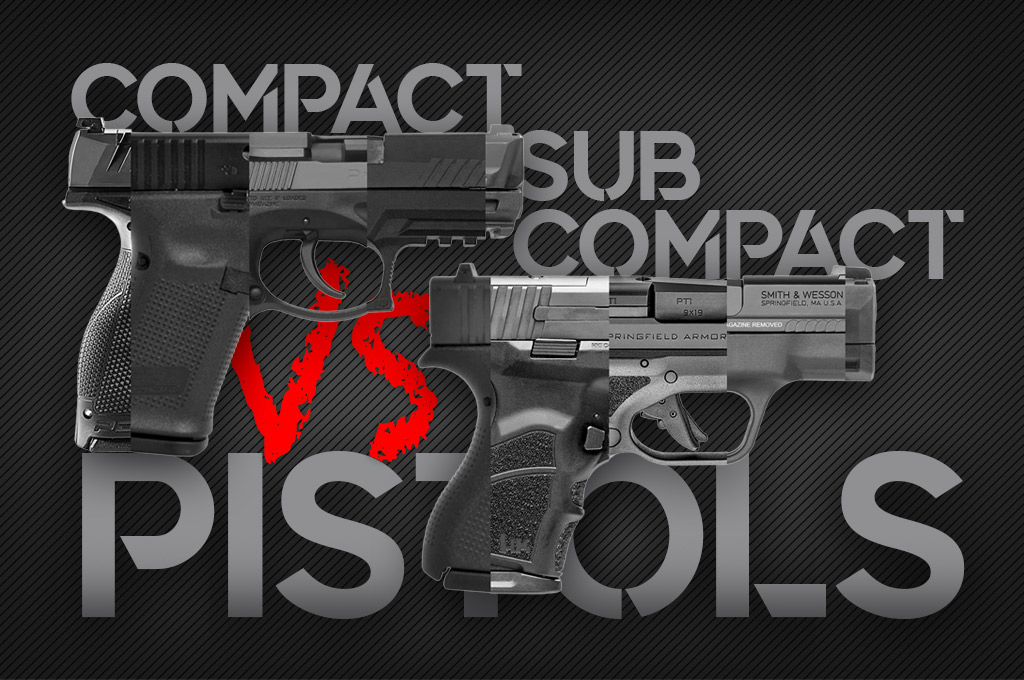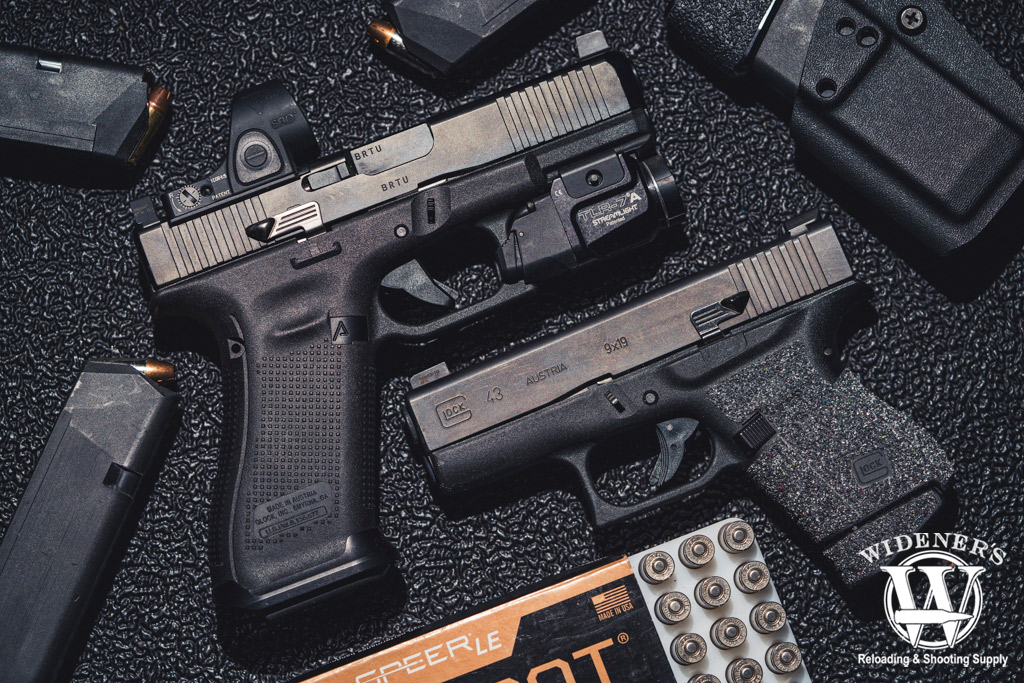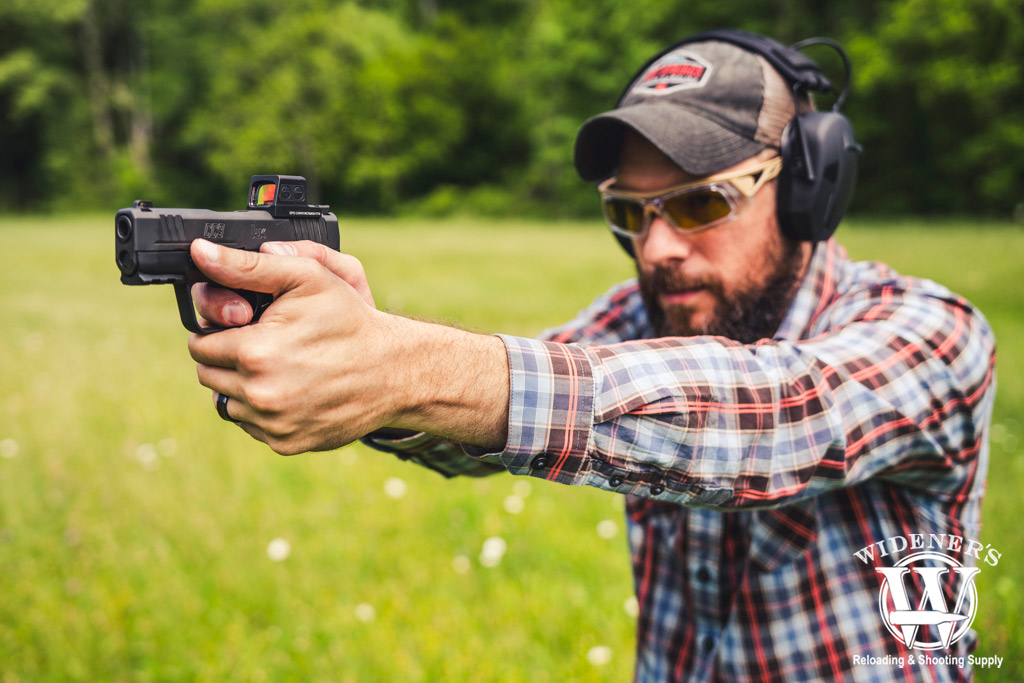

Choosing the right firearm for everyday concealed carry is a highly personal decision that balances size, weight, capacity, comfort, and performance. Among the most debated categories is the compact vs subcompact pistol.
While both are useful for concealment and self-defense, they cater to different needs and preferences. Let’s examine each category’s differences, benefits, and drawbacks, providing examples to illustrate how these firearms perform in everyday concealed carry scenarios.
Understanding The Categories: Compact VS Subcompact
What exactly are compact and subcompact guns? What’s the difference between them? And why do those differences matter?
Compact handguns are slightly smaller than full-sized pistols but retain many features, such as increased magazine capacity, improved ergonomics, and a longer sight radius. These features result in easier target acquisition and higher accuracy. Compact handguns typically feature barrels in the 3.5- to 4-inch range. They’re ideal for shooters who want to balance portability and performance.
Subcompact handguns are smaller and lighter, often with barrels under 3.5 inches. They’re purpose-built for maximum concealability, making them excellent choices for deep concealment or situations where discretion is paramount. Subcompacts often sacrifice capacity and grip size to achieve these benefits.
The Case For Compact Handguns

Compact pistols tend to have longer barrels, larger frames, and more capacity.
Compact handguns offer several advantages for concealed carry, particularly for individuals who care about performance over the smallest possible footprint. Their larger size allows for a fuller grip and better control and accuracy, especially during rapid fire. This is a significant consideration for shooters who may need to rely on their firearms in high-stress situations.
Take, for instance, the Glock 19. It’s often hailed as the gold standard of compact handguns because of its size, shootability, and reliability. Its 4.02-inch barrel provides a good balance of accuracy and portability. The 15+1 capacity is another plus, offering enough 9mm rounds to handle multiple threats without requiring frequent reloads. Its larger size also mitigates recoil better than smaller guns, making follow-up shots easier.
Compact handguns also tend to be more versatile. Many models, like the Springfield Echelon Compact, offer modularity. This allows users to swap frames or slide assemblies to customize the gun for different scenarios. This versatility can make a compact handgun an excellent “do-it-all” firearm for concealed carry, home defense, and range training.
However, these benefits come at the cost of concealability. Compact guns are bulkier, making them harder to conceal under light clothing or for smaller individuals. Holster selection and clothing choices play a critical role in mitigating this drawback. Still, for some, the extra size and weight may feel cumbersome after extended wear.
A shortlist of the best compact handguns:
- Glock 19/19X
- Smith & Wesson M&P Shield
- Beretta PX4 Storm
- Walther PDP
- Springfield Echelon
The Case For Subcompact Handguns

Subcompact pistols tend to have shorter barrels, smaller frames, and less capacity.
Subcompact firearms are designed with one goal in mind: concealment. Their smaller frames and reduced weight make them easier to hide and carry discreetly, even in tight or minimal clothing. This makes subcompacts attractive for people who focus on comfort and discretion in their concealed carry setup.
An excellent example of a subcompact handgun is the Springfield Hellcat. It’s a modern micro-compact with a 3-inch barrel and 11+1 or 13+1 capacity (depending on the magazine). Despite its diminutive size, the Hellcat offers excellent shootability thanks to thoughtful ergonomics and features like an optics-ready slide. It’s a prime example of how subcompacts have evolved to provide better performance without sacrificing concealability.
Another advantage of subcompacts is their lightweight construction. Carrying a subcompact like the Smith & Wesson M&P Shield Plus all day is less likely to cause fatigue, which is particularly important for people who wear their firearm for extended periods. The smaller footprint also makes them ideal for pocket carry or ankle holsters, further expanding carry options.
However, the compactness of these guns often results in compromises. Their reduced grip size can make them harder to control—usually described as “snappier”—especially for shooters with larger hands or during rapid-fire. Another concern is their limited magazine capacity compared to their compact counterparts, though innovations like extended magazines for some models are bridging this gap.
A shortlist of the best subcompact handguns:
- Sig Sauer P365
- H&K CC9
- Glock 43/43X
- Springfield Hellcat
- Smith & Wesson M&P Shield Plus
Balancing Performance & Comfort: Compact VS Subcompact Pistol
When comparing compact and subcompact handguns, the decision ultimately hinges on balancing performance and comfort. Thanks mainly to their larger grip and slightly longer barrel and sight radius, compact handguns excel in performance. They offer better accuracy, higher capacity, and reduced recoil.
These characteristics are crucial in situations requiring precision and confidence under pressure. They also lend themselves well to home defense or range training, where concealability isn’t a concern.
However, this performance comes at the cost of comfort. Larger dimensions mean more challenges in achieving deep concealment, and the added weight can become a burden for all-day carry. Individuals who care about a seamless, low-profile carry experience may find these drawbacks significant.
Subcompact handguns, on the other hand, shine in comfort and concealment. Their smaller size and lighter weight make them easy to carry discreetly—a critical factor for individuals who need their firearm to go unnoticed in professional or social settings. While their reduced capacity and shorter barrels may seem like limitations, modern subcompacts have made remarkable strides in mitigating these issues. They now provide features like extended magazines and enhanced ergonomics.
Personal Scenarios: Compact VS Subcompact Pistol

For colder weather, a compact-sized pistol is easier to conceal; for warmer weather, a subcompact might be the better option.
Choosing between a compact and subcompact firearm requires evaluating your lifestyle and carry needs. If you live in a colder climate where layering clothing is common, a compact handgun like the Sig Sauer P365 XL might be a comfortable option. It will provide performance and capacity without significant concealment challenges. This firearm bridges the gap between compact and subcompact with its slightly larger frame while retaining the benefits of concealment.
Conversely, a subcompact like the Ruger LCP Max might be more practical in warmer climates where lighter clothing is the norm. Its minimal size and weight allow for easy concealment, even in shorts and a t-shirt, making it an excellent choice for deep concealment in the summer.
For those who prefer a “middle ground,” some compact models like the Glock 43 or Glock 43X and Springfield Hellcat Pro aim to combine the best of both worlds. These firearms provide a slightly larger grip and higher capacity than traditional subcompacts while maintaining a compact profile suitable for concealment.
Training & Adaptation
Whether you choose a compact or subcompact firearm, training is key. Compact firearms may initially feel easier to shoot, but their larger size requires more attention to holster selection and concealment techniques. While convenient to carry, subcompacts demand regular practice to overcome challenges like reduced grip size and increased recoil.
Investing in quality holsters, such as an inside-the-waistband (IWB) holster for compact guns or a pocket holster for subcompacts, can significantly improve the carrying experience. Similarly, using accessories like grip extensions or optics can enhance the usability of subcompacts, leveling the playing field for performance.
Conclusion: Compact VS Subcompact Pistol

Compact VS Subcompact Pistol: The “better” option depends on individual needs and preferences.
The compact vs subcompact pistol has its place in the concealed carry world. The “better” option depends on individual needs and preferences. With their enhanced performance and versatility, compact guns are ideal for those who focus on control, accuracy, and capacity. With their ease of concealment and lightweight design, subcompacts are perfect for individuals who need a firearm that fits seamlessly into their everyday lives.
Ultimately, the decision isn’t about which category is better. It’s about understanding your priorities and finding a firearm that complements your lifestyle. Whether you choose a compact like the Glock 19 or a subcompact like the Springfield Hellcat, the most important factor is confidence in your ability to carry and use your firearm effectively. With proper training and the right gear, either option can serve as a reliable tool for self-defense.


